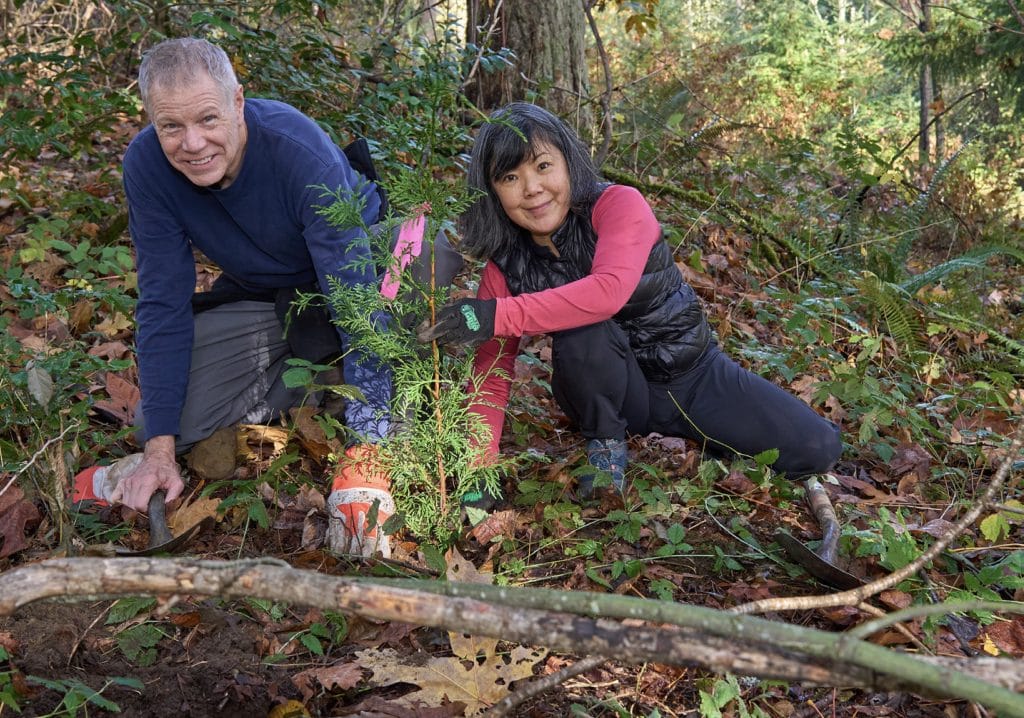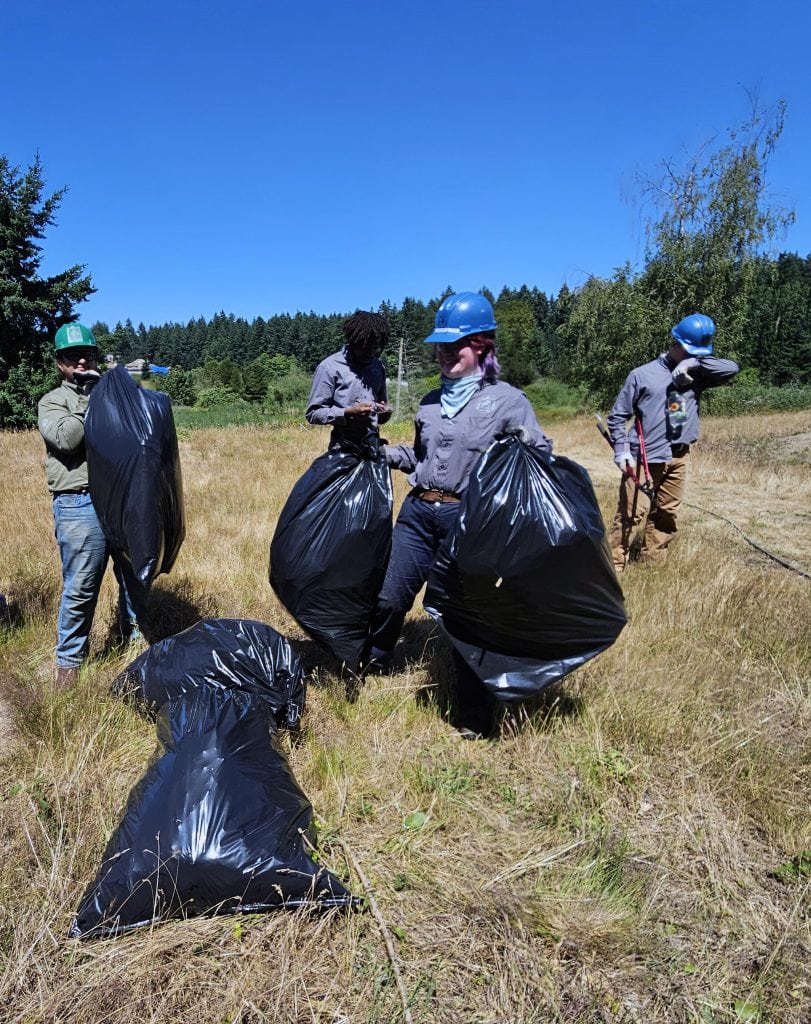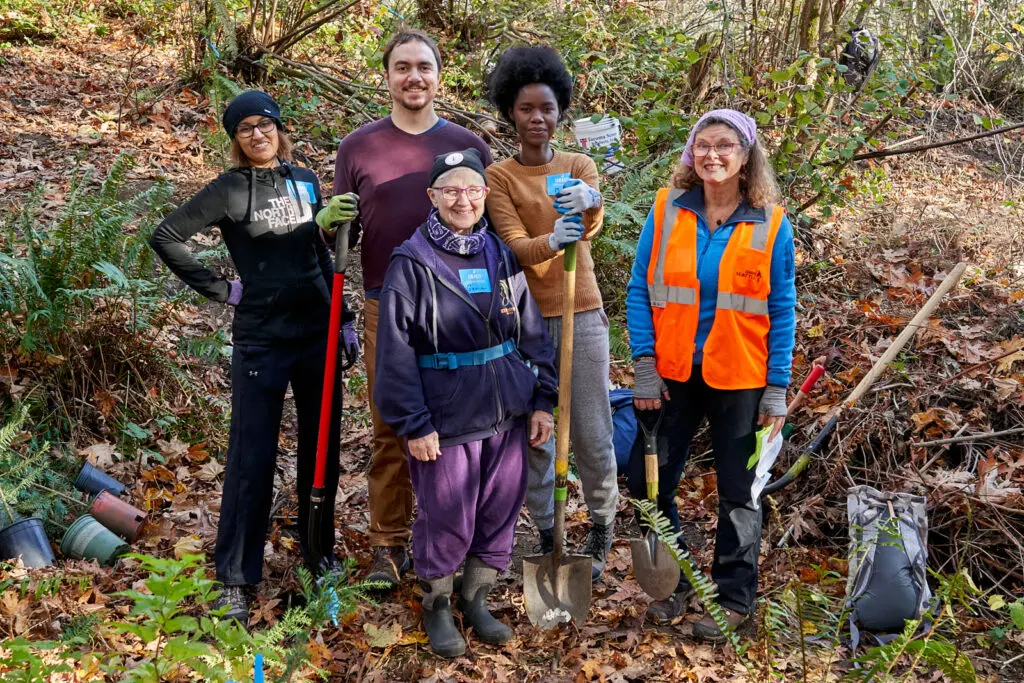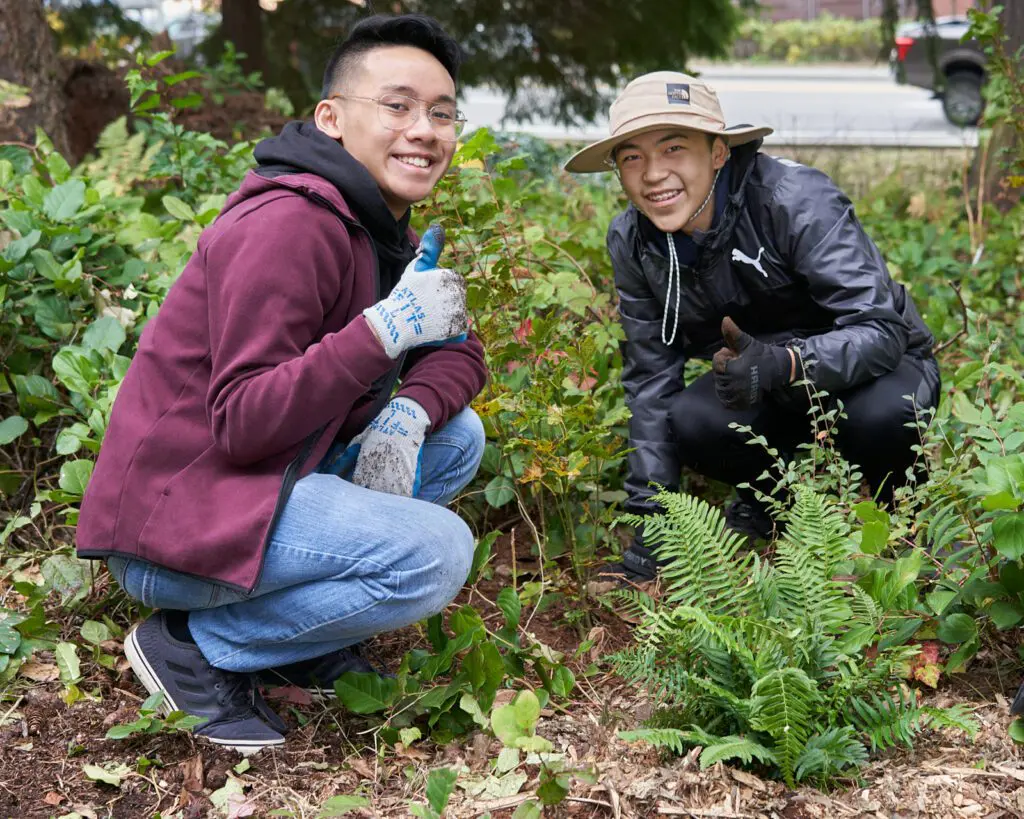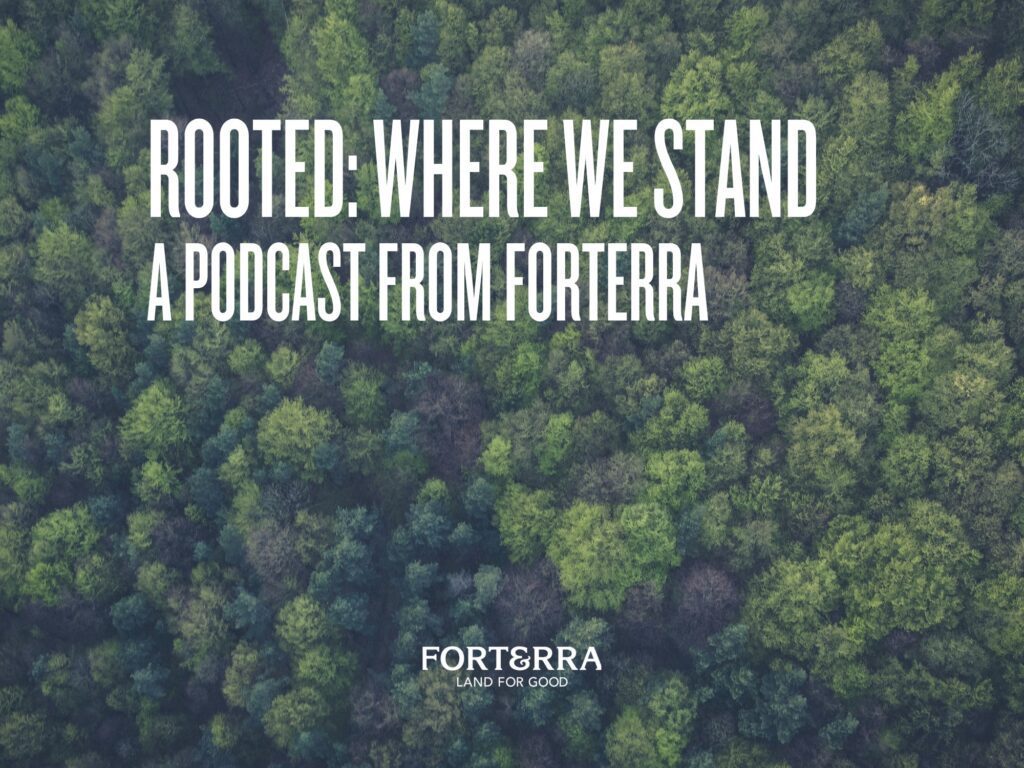
Just a few minutes in nature – even just looking at images of trees – can have positive impacts on our physical and mental health. As the rates of people struggling with their mental health rise globally, we could all use the help.
We’ll learn about some of the research on nature’s effects on human health, from a leading research social scientist.
And then we’ll go back to school to learn what the heck a tree canopy is and why it matters. Well, this school might look a little different than yours, unless you also hugged trees before math class.
Rooted‘s host and executive producer is Kyle Norris. Our editor is Mary Heisey. You can find out more at forterra.org/rooted. And you can contact us at marketing@forterra.org
Find additional episodes here.
More about the tree canopy program
More about University of Washington’s Kathy Wolf
Music in this episode
- Ghost Beatz: Beauty in the Struggle
- Markus Huber: Easy Going Today
- Falls: Fluidity
Transcript for “Without trees, we’re unrooted”
[Theme music]
Kathy Wolf: I’ve been accused of being a tree hugger for a long time and I own it! (laughs)
Kyle Norris: This tree hugger also happens to be one of the leading researchers who studies the connection between nature and human health. And we’re hanging out on a bench in Seattle’s Volunteer Park. With trees that are more than 100 years old.
KW: I like old gnarly trees that remind us of time & age & culture & the change that takes place around us.
Kathy Wolf is a social scientist at the University of Washington’s School of Environmental & Forest Sciences. She travels all over the world talking about the impact trees have on human health.
KW: And I like walking around cities that I’ve never been to before. And once in a while I’ll encounter an old tree I’ve never encountered before. I’m kinda like a tree whisperer and I’ll stop and think about, well what have you seen, what’s happened around you in the many decades that you’ve been alive?
KN: This is “Rooted: Where We Stand.” A podcast from Forterra. I’m your host, Kyle Norris.
[This podcast is brought to you by Symetra. Where people, planet and commitment matter. Symetra Social Impact helps create opportunities, promote education and support social justice programming for underserved communities to ensure fair access and fight the disproportionate effects of climate change. Visit symetra.com to learn more about Symetra Social Impact.]
[Fade out theme music]
Social scientist Kathy Wolf says the outdoors are about way more than just being pretty.
KW: And we used to think ohhh this was about aesthetics, it’s about beauty. And now we realize: mental health, physical health, social cohesion. All sorts of things are associated with these daily important encounters with trees & nature.
There’s so much research that indicates that just a little time outdoors positively affects our bodies and minds. From the way it boosts our immune systems to the way it improves our sleep.
We’re about to dive into a western understanding of science and nature. But I want to say that there are all kinds of ways of knowing all over the world. Like Indigenous knowledge systems. That are old and established and deeply valuable. So when we talk about nature being healing, we gotta acknowledge this is not new to a lot of people and cultures all over the world.
This western research that Kathy Wolf is studying is relatively new. It echoes what older knowledge systems say: Being in nature makes us healthier. And our health needs help.
[Montage of news clips about mental health crisis]
- (“VICE News 1”) In years past, 1 in 5 Americans suffered with mental illness. With the anxiety and isolation of living through a pandemic has the CDC worry that that number could now rise to 1 in 2.
- (ABC News) We want to talk a little bit more about one very serious issue surrounding the pandemic: the US Surgeon General has issued a new advisory on a growing youth mental health crisis warning that depression and anxiety symptoms in young people have doubled worldwide during the pandemic.
- (NBC News) In July, Robert Redfield, the Director of the CDC at the time, said suicides and drug overdoses surpassed the death rate for COVID 19 among high school students.
KN: People are struggling with their mental health, all over the world. Young people are particularly hurting. Especially young people whose lives are impacted by systems of oppression. Like queer youth, youth of color, and young folks from low income households. And social isolation and loneliness play a big role.
KW: People are hurting. Depression, tension, stress, all sorts of things. And what we see is that even brief encounters, some of the earliest research about trees & health that was done in the 1980s, um, it’s really interesting to look at the articles & there’s these scientific charts. And within a matter of minutes, if people are stressed and they see trees, not even walking through it, just simply looking at images, within minutes there is stress reduction.
So just by looking at photos of trees, our heart rate lowers. And once we get outside, our bodies respond in some pretty cool ways.
KW: Other mental health–depression. People with clinical depression, there have been studies showing time in nature, say 60 minutes or so roughly, there’s a reduction in the symptoms of depression. ADHD. Children with ADHD who spend routine amounts of time outdoors, and this is brief: 30, 20 minutes, um show reduced ADHD symptoms. And this is not merely about moving around, physical activity. There appears to be some sort of response in the brain that helps kids to focus more, to pay closer attention to things, associated with time in nature.
In fact, Kathy says a big thing researchers are noticing is how nature helps us to reset and restore our attention. Because, life out there, it’s moving fast.
KW: This plays out I think in a number of different ways in our lives. Sometimes we just overextend ourselves cognitively. There’s so many demands on our attention. Our phones, texts, notifications, the kids! Uh ya know things at work & home & school.
KN: She says nature is a potential antidote to help. In something that’s called “attention restoration theory.”
KW: And this is the idea that our brains & our bodies did not evolve to where we are now, where we focus so long on tasks. Focus on a monitor, focus on a budget, focus on a report. Our minds have been doing that in relatively recent times.
KN: Kathy says, as a result we can become fatigued. In our heads and bodies.
KW: And you may feel frustrated or you may feel like you’re not thinking straight. And there’s even been studies recognizing that impulse control is reduced and aggression may actually be increased. So these studies show that time in nature, again very brief amounts of time and you don’t have to go far away to the mountains or ocean, just your backyard, a neighborhood park, um helps to restore that attention.>>
KN: So, trees are proven to positively affect human health – both physical and mental – in many ways. And there’s this term people use when talking about the amount of trees, and that’s: “tree canopy.”
KW: Of course trees, around us, we’ve got these beautiful beech trees, the lily & poplars & hollies and all sorts of things. So there are individual trees that have individual character, age, shape, form. But then canopy…is the bird eyes view as you imagine moving over them.
KN: So picture you’re flying above your town. The tree canopy is the area covered by green – the trees, bushes, & shrubs.
KW: And why do we talk about canopy? Because it’s a measure many cities use now, it’s kind of a benchmark of the extent & the health of the urban forest.
And there are programs popping up across the country to increase tree canopies in a specific type of place…Schools.
KN: We’re pivoting from an old, established park in Seattle to a small urban forest in Burien, Washington. At the back of the Highline school district’s property.
Briana Diaz Contreras: Uh my name is Briana Diaz Contreras. Uhhh I’m 17 and I’m living life bro.
KN: Briana’s a senior at Highline Big Picture High School. At Big Picture schools, students design their learning based on what they’re interested in. Sothey’re evaluated on internships and projects, more than tests.
Last year Briana took part in an environmental leadership program for students in the Highline School District. Called WELS. Right now, she’s showing me this baby forest she helped create.
We’re standing on a bunch of dried mulch. In a circular area that can be an outdoor classroom, with stumps for chairs.
BDC: We’re in a ring of logs, ya know, it’s like a space for everybody. There’s a forest in front of us, with a bunch of madrona trees. And there’s a bunch of little plants everywhere, baby plants. We got like maple leaf, we got fir trees, like baby firs, we got ocean spray around us. We got like lil trails around us.
Briana participated in a pilot program to help grow tree canopies in cities near the SeaTac airport – one of the busiest airports in the U-S. The spot we’re standing in? It’s the baby forest Briana helped create. One mile from the airport.
Airplanes soar above the school every two minutes. Imagine that as you’re sitting in class.
Increased tree canopy helps buffer the noise. It also provides shade and improves air quality.
Several organizations partnered to make this pilot program happen: The Washington Department of Natural Resources, US Forest Services, Highline School District, the Port of Seattle, and Forterra.
Other leaders in this initiative? Students and community members. Like Briana. Briana’s job was to help plant trees and create this cool outdoor space. One of her favorite things, though, was digging up tons of invasive blackberry bushes.
BDC: It was Himalayan blackberry and that’s an invasive species in WA. So our big goal was to get rid of all of that, but it was kinda hard. So I brought my personal leather gloves. And with just a shovel, and some hard work and leather gloves I would just go at it. I’d wear like a sweater and stuff so I wouldn’t get poked everywhere.
KN: She said ripping this stuff up was no joke, bro.
BDC: So I was like I have the muscles to do this. I have like, I guess I’ve always been more, like, naturally strong. So I was like yeah man, I always like a challenge. This is cool. And I also grew up in Hawaii on a farm, on a coffee farm and I’d always see my parents hustling, doing hard work. And I was like ya know, I dunno I just grew up around this type of environment, so this is something I enjoy.
KN: Her teacher Michael Stein-Ross ran the program. He’s with us as we walk toward the forest they helped clean up. It’s an established grove of Madrone trees.
Our resident social scientist and “tree whisperer” Kathy Wolf would love them… at times their bark gnarled and knotted, other times it was smooth to touch.
Michael Stein-Ross: Madrone is a very cool tree. Really important to the region. Um and it’s kind of special that we’re able to have this on a school campus. Uh, so we bring students down here sometimes just to push the envelope a little bit, push their comfort zone. Um and so…have ‘em maybe do a little meditation, but like while hugging a madron.
KN: I asked Briana and Michael if they’d lead me through a forest meditation like the ones they do during school. Michael invited me to pick my own tree. But I was holding my microphone, recorder, cable, and headphones. And then, some thorny Himalayan blackberry vines attacked me.
KN (in the forest): Ah it got me. It got me. The pickers got me! Ok.
KN: Honestly it was a little much to record and hug a tree at the same time. So I just observed.
MSR: So I’m gonna take this one right here, Briana why don’t you choose…I dunno look around and choose one that calls to you. That you’re like oh yea that’s my tree!
KN: The meditation starts with Michael inviting us to close our eyes and touch a tree. Briana stood behind her tree and hugged it. The way you’d stand behind your prom date and clasp your arms in front of them.
MSR: And I know we have a lot going on today, we still got a full day of classes. But take this moment now where you’re at. How lucky are we to have this forest on our campus right? That we can just walk out here into this beautiful space. In some way right now, maybe, share some gratitude with that tree. You don’t have to speak out loud. But the tree that you found today, share a lil gratitude. Take a few deep breaths, smelling the forest around us. What’s it like this morning?
KN: Although I’m sitting this one out, I loved slowing down with Briana and Michael. Being together in the quiet…just made me feel closer to them.
MSR: I know we’re in the city and planes are going by but what other sounds do you hear? Maybe the wind thru leaves right now, maybe that bird over there. Pick up on those sounds. (Bird sounds) Just notice. Simply notice what’s out there.
KN: I definitely heard a cool bird. And an airplane.
MSR: In the next few breaths when the moment feels right, you all can open your eyes & gather back here in the center. Say goodbye to your tree for now. Come on back grounded, ready to take on the day.
KN: Briana says, doing this affects the quality of her school day.
BDC: Uh we usually do this before math class because ya know math is something that takes a lot of brain power sometimes. And so doing that really like helped us unscramble our brains sometimes and get us more prepared. So it really makes me feel more mellow and also appreciative for the trees though, big time.
KN: Michael says he saw results quickly. The meditations helped students relax and focus in class. This observation is supported by some really cool research. Here’s Kathy Wolf again.
KW: There have been studies about school performance. Children. And some of the studies are about the landscape of the school–views from the classroom window. Or the landscape or forest canopy around the school. And each of these, it’s not entirely consistent, but many of these studies are showing better school performance in terms of standardized testing, graduation rates & things like that.
KN: Michael sees another interesting effect the program has on students.
MSR: I start to see them establishing, like discovering personal connections with nature. And that’s ultimately like, more important to me, is that. Because they’re gonna grow up and then start caring for nature, right, if they have this personal connection. Um if they start to love it, if they start to know it in an embodied way through their senses.
KN: Take Briana. When she first got involved with this program, she was still new to the school and Washington State.
MSR: She’s a great observer, so she’s looking around, scoping things out. Seeing who’s who. But once we gave her an opportunity to step into a leadership position she kinda started blossoming, uh immediately.
KN: She became a high school leader in the outdoor leadership camp they do for 6th graders. She started doing PR for the student body government. She even did community engagement for this tree canopy program.
BDC: Well that helped me talk to a lot more students and just talking to more people in general and being more open. So I guess that was healing, because I was like I’m kinda lonely. And now I’m like, wow I actually connected with these people I did not think I’d connect with at all. And now I have, like, friends, which is crazy. So I guess it was healing to a certain part, yeah.
KN: Michael says these pandemic years have been unsettling for students. And he saw that they needed something different. And this tree canopy project addressed that.
MSR: There was so much community trauma in people, students trying to figure out how to be with other people again after a year and a half in their rooms at home. That really, there was something very soothing, uh I dunno…medicinal maybe…or I don’t know what the word is…healing, there it is!…about the work we did with students here. You could listen to them talk about their experience. And it was always gratifying. That’s what they needed. They needed this year to be outside more than ever.
KN: These kinds of models are the future. What I mean is: creating outdoor spaces that are meaningful to the people who live there, and giving them ways to connect with nature and each other. That’s according to our expert who loves gnarly trees–Kathy Wolf.
KW: That’s where we should be headed, absolutely. And I get the sense that Forterra & other non-profits are on board with this. They’re realizing this. Where they used to be conservation groups largely driven by ecological goals. “Well we’ll conserve that place. Do we want people there or not.” It’s really flipped to: how do we acknowledge, conserve and engage, all at once. In ways that benefit the landscape but also benefit the human community.
KN: It only takes a little time in nature to feel better. We’re talking 10 to 20 minutes.
And you don’t have to climb a mountain or kayak the seven seas to do this. You can find some green in a park or a yard. And that short time outside can help “unscramble your brain” and make you feel more mellow, as Briana put it.
In fact, there’s an easy rule you can remember, in terms of what we’re aiming for in tree canopy coverage. It’s for cities and schools and for people.
It’s called the “3/30/300 rule.”
It means every person should be able to see 3 trees from their home. That there’s a 30% tree canopy over residential areas. And that everyone lives within 300 yards of a park or open space. Which would take about 3 minutes to walk to.
So next time you’re outside, take a pause and see if the 3-30-300 rule holds true for you.
Thanks for listening to “Rooted: Where We Stand.”
Rooted’s Host and Executive Producer is me, Kyle Norris. Our editor is Mary Heisey.
You can find the sources we used in our research on this episode in the show notes.
“Rooted” was created by Forterra. A land trust that envisions people and nature thriving together in a place where everyone belongs.
And hey! We loved our conversation with social scientist Kathy Wolf so much, we’re making that our next episode. You can listen to that & find more episodes of “Rooted” at forterra dot org.
